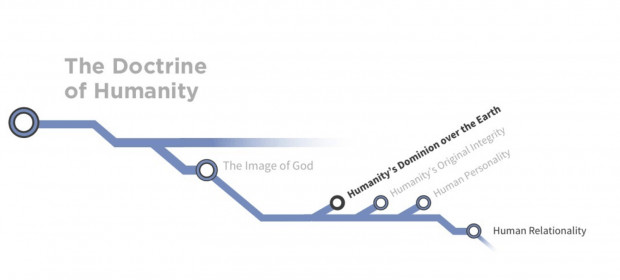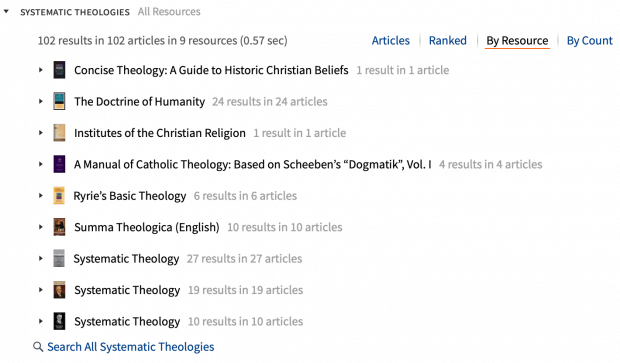Remember always to go on to theology. — Mark Ward
In preaching and other Bible teaching, your big strength can become a weakness. If you are good at careful analysis of biblical texts, don’t stop there. Remember always to go on to theology. Analysis and synthesis belong together, like hot air balloons and magnifying glasses.
The Lexham Survey of Theology is my go-to tool for systematic theology (I happened to be the general editor). This very morning I was writing about the image of God for sixth graders in a freelance project, and my go-to source for help was the LST. Well-known writer Gerald Bray wrote the piece on the image of God, and it set out for me the key points and key texts I could share with my young readers.
I also checked one of the articles “underneath” the image of God in the mind map that organizes the LST.
The mere fact that “Humanity’s Dominion over the Earth” is included underneath “The Image of God” suggests that the dominion may be a function of the image. And Dr. Naomi Noguchi Reese helped me immensely by laying out that and the two other major views of what the image is.
This functional view holds that the image consists of something humans do—namely, rule over God’s creation. This contrasts with a substantive view that understands the image as consisting in uniquely human attributes (for example, a moral sense), and a relational view that perceives the image as the human capacity for interpersonal relationships.
This is just what I look to the LST to give me: two levels of synthesis. Dr. Reese has not only synthesized the Bible’s teaching on the image of God in short space; she has synthesized the long-term discussion about that teaching, boiling it down to three major viewpoints. I find that when I have a framework like this, I get more out of what I go on to read in my systematic theologies.
And that’s just what the LST helps me do. At the end of every one of the 243 articles is a link to my systematics in Logos. And each one is tied to that portion of the theology which deals with the doctrine in question.
Here’s what I see in the relevant guide section of my own personal Logos account: I’ve got Packer, I’ve got my IVP Contours series, I’ve got Calvin, I’ve got two Catholic STs surrounding Ryrie—not sure how he’d feel about that. Strong, Hodge, and Berkhof round out my personal collection.
When I clicked on Packer’s (as always) well-written treatment, I saw precisely what Reese’s introduction led me to expect. Her categories helped me anticipate and then process Packer’s contribution. The same went for Sherlock’s extended historical survey in the IVP series, which I skimmed and dipped into here and there. Having a framework is, I find, always necessary for good skimming. And I find I get through more material—weigh more insights and options—when Logos puts them all a click away. The LST helped me in at least these two major ways.
Systematic theology and Logos
This is Logos Bible Software at its best: culling through your library to give you just what is relevant to your study. And now, with the Lexham Survey of Theology, Logos assists you not just with exegesis but with systematic theology.
My Logos Library contains even more books referencing this topic—including the stimulating approach taken by Richard Lints in his Identity and Idolatry: The Image of God and Its Inversion (from IVP’s New Studies in Biblical Theology). Lints does something simple and brilliant: he contrasts the image of God with its opposite, the making of idols.
In the end, I ended up taking what I’d call a minimalist definition of the image of God—in part because of what Lints said:
Theologians have every right to be interested in questions of human nature, but the unfortunate consequence is that they have therefore made the construct of the imago Dei bear more conceptual weight than it was intended to bear. The context of the primary occurrences of the imago Dei in Genesis 1–9 strongly argues against construing the imago Dei as a grand metaphysical construct. If anything, the context demands a certain theological humility regarding this. (35)
After reading a bunch of gifted theologians’ assessments of the meaning of the image, I had to award top points to Lints. His careful theological discussion brought me full circle, to reinforcing what my exegesis of Genesis 1 led me to see already, namely that the functional definition of the image of God more or less requires the substantive one—so it is safe to put them together as constituting the image. In fact, the relational view is also implied by the functional view: in order for mankind to multiply and fill the earth, they must have relationships. I like what Anthony Hoekema says in his now classic study, Created in God’s Image:
The concept of man as the image or likeness of God tells us that man as he was created was to mirror God and to represent God. (67)
In my lesson for sixth graders, I wrote this:
Genesis says we are made in the “image” and in the “likeness” of God. An “image” represents a person. A statue or a photograph, in a way, “mirrors” a person to anyone looking at it. If you throw darts at someone’s picture, or knock the head off his statue, you are dishonoring that person. If you cherish that photo, or if you put the statute in the center of your house, you are honoring that person.
It is simplest to say, then, that to be created “in God’s image” means that we were created to be like God and to represent him, to mirror him to the world. We all do it, whether we want to or not. But we throw darts at God’s image when we live sinful lives. We mess up the image. We are often very bad mirrors of a holy God; we start to image idols instead.
My words were directly influenced by what I read in the Lexham Survey of Theology.
Get your copy of Wayne Grudem’s Systematic Theology, An Introduction to Biblical Doctrine, Second Edition, the most widely used resource in its field.








